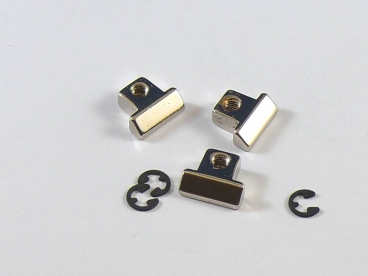Once you’ve decided on what type of saddles you want to add to your existing bridge Faber bridge, it’s time to install them. If you are unsure what material saddles will be best for you then you can check out our handy video guide Faber Bridge Saddle Removal and/or our blog post, What Faber Bridge Saddles Should I Get?
Saddle installation is a relatively simple process which most people should be able to perform without any trouble. If you are unsure on any step of the process, please consult a professional luthier.
Before attempting to remove the saddles, remove all tension from the strings. Many players find the optimal time to perform bridge maintenance is during a re-string as the strings will already be taken off the guitar. This will allow you extra space to work without the loosened strings getting in the way. If you do choose to perform this task with the strings slackened off, doing most of the work away from the guitar would be beneficial to allow for space.
All you need to change the saddles on your bridge is a crosshead screwdriver, a small “jewelers” screwdriver, and a pair of needle nose pliers. Be sure to use the correct size screwdriver for the saddle adjustment screws so that the screw heads do not become damaged.
Once the strings are off the guitar, remove the bridge and loosen the saddle adjustment screw of one saddle until the saddle comes off the thread and can be lifted out of the bridge. Some vintage USA style bridges will have a retaining wire holding the saddle screws in place, Faber bridges do not have this wire. You may choose to remove all 6 saddles at once or you may choose to remove one at a time and replace each one as you go along.
To install a new saddle, place it into the bridge with the flat edge facing the saddle adjustment screw hole. This will also face up towards the pickups. Take the bridge saddle screws and saddle screw retainer rings and thread them through the hole on the bridge so it catches the thread in the middle of the saddle. Tighten the screw until it reaches the back of the bridge and is holding the saddle firmly in place. Repeat this process for all the other bridge saddles.
Once all six saddles are in place, reinstall the bridge with the saddle adjustment screws facing the pickup. Restring the guitar and tune it to your desired tuning. Once in tune, the intonation will need to be set. To set the intonation, you will need to check the tuning of the open string against the fretted 12th fret with an electronic tuner. If the 12th fret is sharp compared to the open string, the saddle will need to be moved away from the pickups, lengthening the string. This is achieved by loosening the saddle adjustment screw. When loosening the screw, the saddle movement will apply extra tension to the string making the pitch raise. Retune and check the intonation again and keep adjusting until the strings open pitch matches the 12th fret.
If the 12th fret note is showing flat compared to the open string, then the string will need to be shorted by tightening the saddle adjustment screw to move the saddle closer to the pickups. This motion will reduce the pitch on your string. Once the adjustment is made, retune and check the 12th fret note again. Continue adjusting until correct.
If you are using one of our Nashville style bridges and you find that you have run out of space to adjust the saddle further, these bridge saddles are designed to be turned around to provide extra room for further intonation adjustment. Turning the saddle should allow you to get the extra movement you need for perfect intonation.
When adjusting the intonation, check progress regularly and make small adjustments. For a full detailed run through of setting the intonation on Faber bridges, Check out our Guide.
Once you have completed setting the intonation of your new Faber bridge saddles you can start to enjoy the benefits that the saddle upgrades bring you. Our saddles are superior quality and will improve the tone and feel of your guitar. If you chose our titanium saddles you will notice an increase in brightness on your guitar, this is great for muddy pickups.









